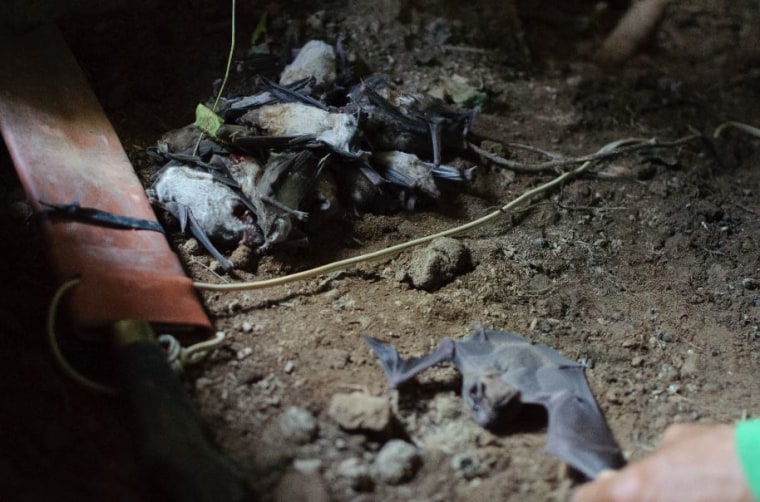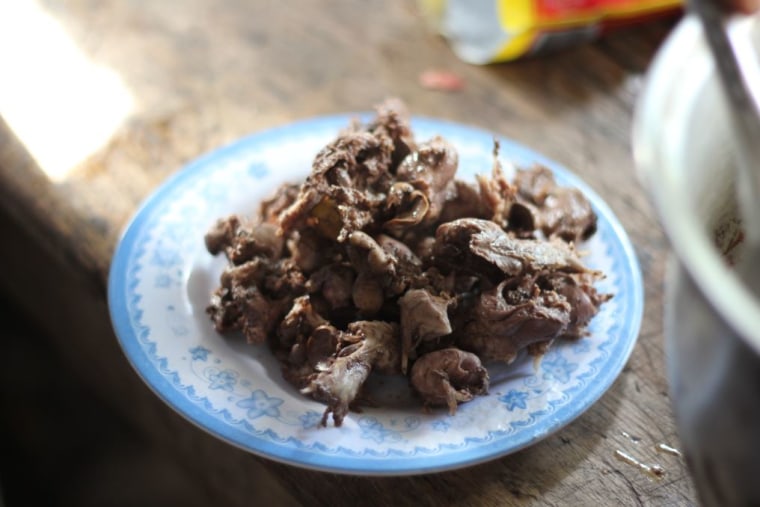MAYANTOC, Tarlac, Philippines — To go bat hunting, Jack Carbonel puts on a headlamp, straps a machete to his waist and makes a spear by lashing a sharpened metal stick to a thin bamboo sapling. He waits until noon, when the bats are asleep and the forest spirits are less vindictive. Then he climbs the steep mountain, hacking through thick tropical foliage, barbed vines and thorny branches.
Carbonel knows the path well. “I’ve been coming here since I was about ten years old,” he says, “with the kids I grew up with, and with our fathers.”
At the peak of the mountain is a stack of massive volcanic boulders. Between the stones are damp, cool-smelling caves where swiftlets — energetic little birds — build cup-shaped nests and pythons feast on mice and other cave-dwelling critters. Carbonel kicks off his flip flops, takes a running leap up ten feet of boulder, shimmies up a crevice and wedges himself in tight.
In Tarlac, bats, along with field rats, frogs, pythons and crickets are part of the same lowland forest food chain, and have long been part of the regional cuisine. Carbonel has climbed the mountain to collect some dinner.
As he inches closer to the roost, a few bats are startled awake, launching themselves into the air with a fleshy flap of wings and a high-pitched screech halfway between a chirp and scream. The bats fly like drunken birds, flashing their webbed silhouettes against patches of noontime sky.
Most of the bats keep dozing. They’re fruit bats about the size of a child’s fist with taupe fur as soft as a rabbit’s. Carbonel grabs a couple with his bare hands. He doesn’t flinch when they bite and draw blood. “They can’t hurt you,” he says and sticks them in his pocket. With his spear, he reaches up and pierces a few more, stacking them up like chunks of meat on a kebab.
He and his brother Jayson collect a couple dozen bats and gather them in a pile on the cave floor. Carbonel lights up a cigarette as he skins the bats, peeling off the fur, head and wings in a few swift strokes.
Carbonel is a wiry man with an incomplete set of teeth and a big smile. He looks about a decade older than his thirty-one years and doesn't say one word more than he needs to. He’s a rice farmer, and he spends most days stooped over the terraced fields next to his cement block house far down a one lane road outside a village in Tarlac province, five hours north of Manila.
While the idea of eating bats gives most Filipinos the creeps, in Tarlac, the opinion seems unanimous: “Masarap yan!” They’re delicious, tastier than chicken.

During the hottest season, Carbonel comes up when the mood strikes him. Sometimes they make a picnic of it, bringing up a pan and a sack of charcoal to cook and eat the bats in the coolness of the cave. “It’s almost like having air-conditioning up here,” he says.
Lisa Marie Paguntalan, Director for Field Operations for the Philippines Biodiversity Conservation Foundation, says that the number of fruit bats has declined rapidly in the last fifteen or twenty years. Where they once saw 50,000 or even 100,000 bats in a single colony, they are now seeing much smaller roosts of about 1000. But its not the voracious appetites of hunters like Jack Carbonel who caused this drop in population. According to Paguntalan, the bigger problem is habitat degradation. As people crowd into the cities, the urban sprawl pushes out into the forest. Trees and caves are bulldozed and cemented over, leaving fewer nooks for bats to roost in. The bat species that can adapt to living in hostile environments are few, with numbers that never soar to those in their natural habitats. Hunters may play a part in the decline of bat populations, but it’s a small one.
Back in their simple kitchen, Carbonel slides the skinned bat carcasses into a metal bowl and begins gutting them. He rinses them inside and out, chops them up into small pieces and stews them over a wood-burning stove. His wife Virginia goes outside to gather guava leaves to soften the gaminess. She adds it to the stew. Once the meat is tender, Carbonel drains the liquid and sautés the bat with onions, garlic and soy sauce.

He plates the bat meat and puts it on a small table with a bunch of tiny señorita bananas he just picked from his yard. It’s a simple spread, and they nibble on the rich meat with their fingers. Outside, his son chases his pet pigeons across the grass and ducks waddle across the acres of rice paddies that fade into the horizon.
It’s an image of provincial idyll, but Virginia breaks the silence to say, “mahirap din ang buhay dito.” Life is hard here too.
There’s no money in subsistence farming, and it’s always in the back of Carbonel’s mind to follow his brothers and sisters to the city for work. If he does that, he may no longer have bat blood on his hands, but he’ll be part of the tide of city-dwellers edging out the bat habitats, making meals like this one harder to come by.
Follow Aurora Almendral on Twitter @auroraalmendral or auroraalmendral.com.